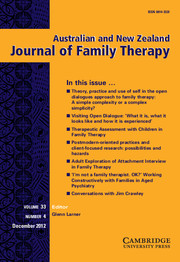Article contents
Group Cohesion and Homework Adherence in Multi-Family Group Therapy for Schizophrenia
Published online by Cambridge University Press: 03 August 2012
Abstract
This study examined the relationship between levels of group cohesion, defined as whole group relationships, and between-session therapeutic homework adherence in a multi-family group therapy (MFGT) for people with schizophrenia. Participants from 18 consenting families attending MFGT groups completed weekly homework adherence ratings, group cohesion and spontaneous between-session activity measures. Levels of group cohesion at each session were compared with measures of scheduled and spontaneous homework adherence reported at the next session. It was hypothesised that higher levels of group cohesion would be related to homework adherence and other spontaneous between-session therapeutic activity completed by group members. Results show higher levels of group cohesion were associated with higher rates of spontaneous between-session therapeutic activity. However, contrary to expectations no significant relationship between cohesion and scheduled homework completion was found. The implications of the findings for group processes and homework adherence are discussed.
- Type
- Articles
- Information
- Australian and New Zealand Journal of Family Therapy , Volume 33 , Issue 2 , June 2012 , pp. 128 - 141
- Copyright
- Copyright © The Authors 2012
References
- 2
- Cited by


